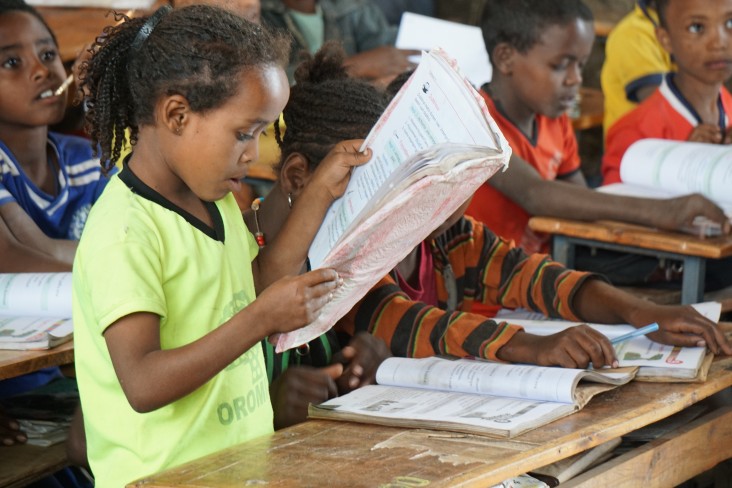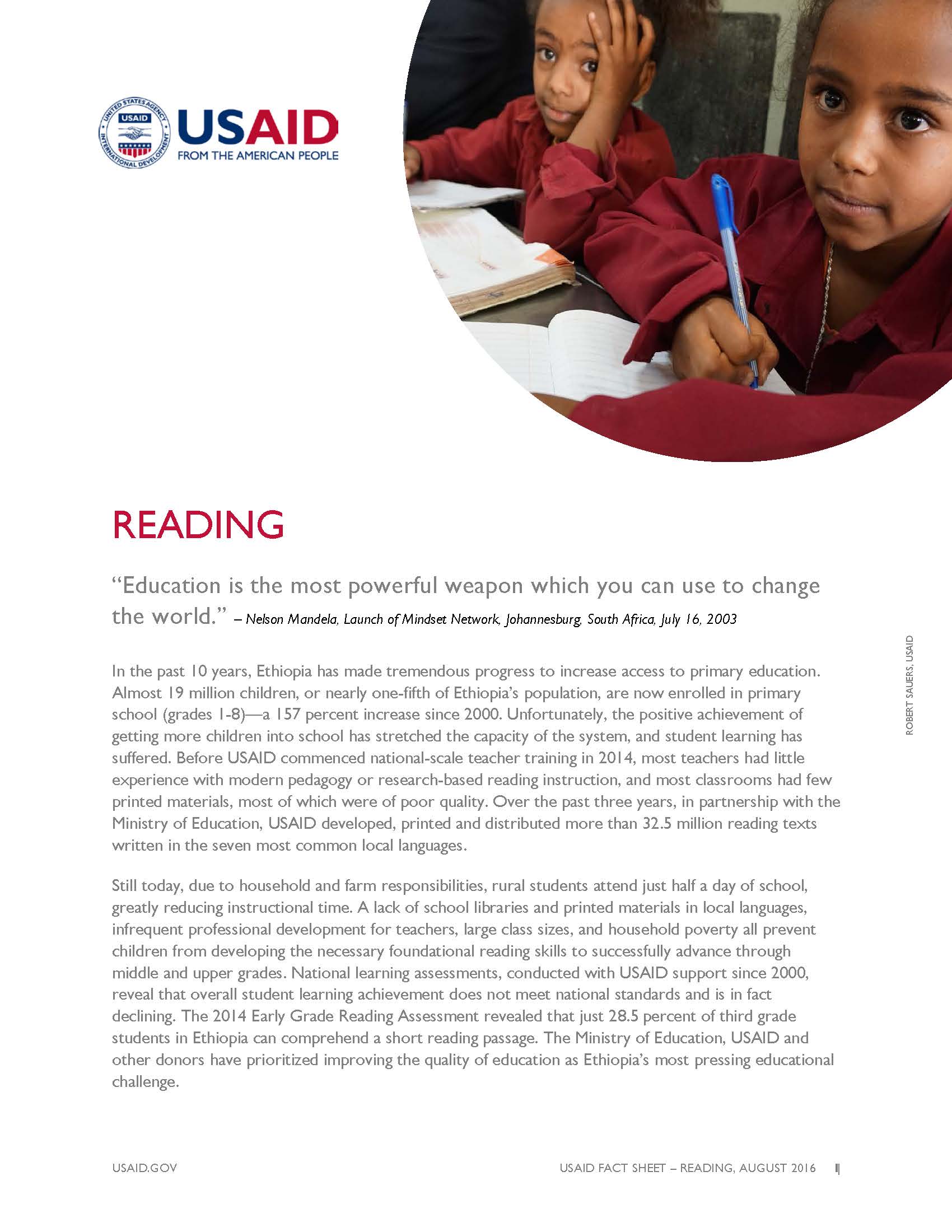
Our mission in Ethiopia supports the Agency's Education Strategy and the mission’s development objectives by planning, managing, and monitoring activities that achieve results across multiple levels of the education system. For more than 20 years, our activities in Ethiopia have addressed a variety of needs related to access, equity, quality, and relevance. This has been accomplished in close partnership with the Ministry of Education and regional state education bureaus. Today, quality of education remains the biggest challenge and priority facing the Ethiopian education system.
International research has conclusively demonstrated that children who do not attain reading proficiency at the primary level are on a lifetime trajectory of limited educational progress and limited economic and developmental opportunity. Ethiopia’s first Early Grade Reading Assessment, funded by us in 2010, showed very low reading performance for first through third grade students across the country: approximately one-third of second graders were non-readers and approximately half scored zero on a comprehension test. These devastating results prompted us to prioritize early grade literacy, partnering with the Ministry of Education and regional state education bureaus, and linking with other donors to implement a comprehensive, country-wide approach to improving students’ learning outcomes. In Ethiopia, we are on track to improve the reading abilities of 15 million primary school children. Major activities supported by the mission include:
-
Improving the reading and writing skills of students in primary schools, with an increasing focus on vulnerable populations and traditionally underserved communities
-
Developing national curriculum in English and local languages
-
Providing quality materials to support instruction and out-of-school activities
-
Improving the professional capacity of 1st through 8th grade teachers
-
Improving the planning and management capacity of the primary education system at national, regional, district, and community levels
-
Strengthening parental and community involvement
We work closely with donor partners and the private sector to leverage support for its activities, including through the Ministry of Education’s $550 million multi-donor funded General Education Quality Improvement Program to which we are contributing $11 million.
In addition, we implement a workforce development activity which targets more than 34,000 unemployed and underemployed Ethiopian youth (ages 15 to 29).
Major Activities
-
Reading for Ethiopia’s Achievement Developed - Technical Assistance: This activity focuses on establishing a firm foundation for high-quality teaching and learning. It trains teachers and develops curriculum and associated teaching and learning materials in order to improve reading in primary schools. The activity has successfully developed a new national reading curriculum and more than 200 textbooks for seven mother tongue languages, printed and distributed approximately 2.6 million textbooks and teacher guides, and trained more than 190,000 primary school teachers who are now prepared to implement the revised reading curriculum. Working in close partnership with the Ministry of Education, USAID will impact more than 75 percent of primary school children nationwide.
-
Reading for Ethiopia’s Achievement Developed – Community Outreach: This activity increases access to appropriate reading materials; provides children with additional and much needed opportunities to practice reading at home, in the larger community and in schools; and strengthens parental and community support for reading while increasing the capacity of Ministry of Education and regional state education bureaus through joint implementation.
-
Reading for Ethiopia’s Achievement Developed – Monitoring and Evaluation: This activity primarily focuses on monitoring and evaluation of early grade reading fluency and comprehension.
-
USAID’s Building the Potential of Youth: This workforce development activity targets unemployed and underemployed youth in the Afar, Amhara, Oromia, SNNP, Somali and Tigray regions. It incorporates many of the best practices and directives outlined in the Agency’s Youth Policy, while incorporating a learning agenda to our work. It complements the mission’s existing agriculture and private sector development programs. Its primary goal is to help youth increase their assets and incomes through employment or better employment to achieve economic self-sufficiency. It also builds the capacity of local institutions to continue this work in the long term. Rural youth receive literacy, numeracy, and life skills training--alongside vocational and entrepreneurship development activities--through partnerships with training, small-business, and micro-finance institutions. This activity targets 30 districts and will reach 35,000 youth, with a focus on the most vulnerable—particularly women—and those transitioning out of pastoralism.
Articles
-
"Tsehai Loves Learning" Speaks to Young Readers in Ethiopia [FrontLines]
-
The Education Alternative [FrontLines]
-
Ethiopia Removes Reading Hurdles for Students and Teachers [Transforming Lives]
-
Scholarship Gives Education and Hope [Transforming Lives]
-
USAID Revives Boys and Girls Scouts in Ethiopia [Transforming Lives]
-
USAID Higher Education for Development Initiative Builds a New Cadre of Professionals for Ethiopia’s Water Sector [Transforming Lives]
-
50 Years of Achieving Real Results in Childhood Literacy [Impact Blog]
-
Ethiopia Partners with the U.S. to Put Girls’ Education First [Impact Blog]
Related News
-
USAID Provides School Supplies for Students in Drought Affected Areas (December 27, 2016)
-
One Million Books to Read (October 26, 2016)
-
Saving Lives with Puppets (February 4, 2016)
-
USAID Addresses Employment Challenges Among Youth Through Economic Strengthening Hubs (November 30, 2015)
-
USAID Increases Access to Educaion for 1.5 Million Students in Underserved Communities (September 30, 2015)
-
U.S. Government Celebrates International Women’s Day (March 5, 2015)
-
USAID and Ministry of Education Launch a National Mother Tongue Reading Program (October 29, 2014)
-
Commencement of the University Preparation Camp for Ethiopian Young Women (December 5, 2012)
-
New Textbooks to Help Ethiopian Students Improve English Language and Reading Skills (November 29, 2012)
-
Remarks by USAID Mission Director: Signing of Development Assistance Agreement with the Ministry of Finance and Economic Development (June 19, 2012)
-
USAID Higher Education for Development Initiative Builds a New Cadre of Professionals for Ethiopia’s Water Sector (March 27, 2012)
-
50th Anniversary: USAID (February 17, 2012)
-
USAID and Ministry of Finance and Economic Development Sign Major Agreements for New Development Programs (June 19, 2011)










Comment
Make a general inquiry or suggest an improvement.